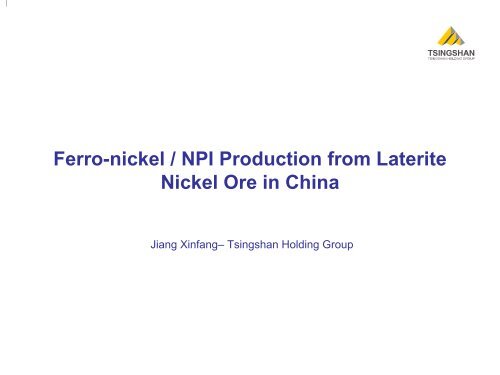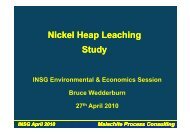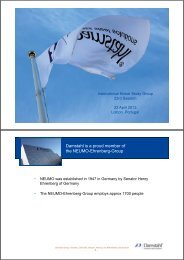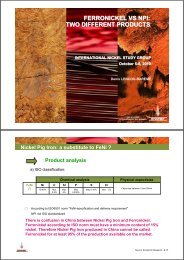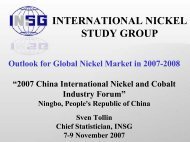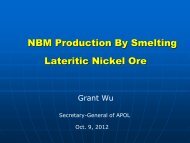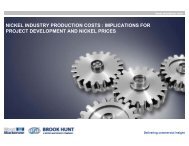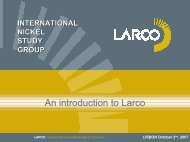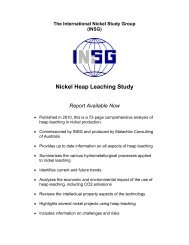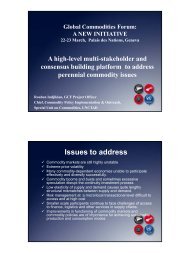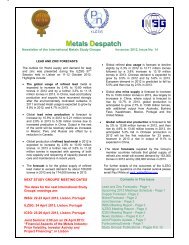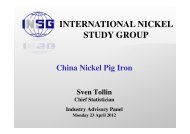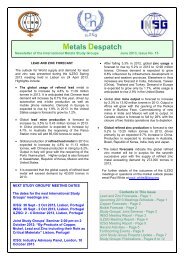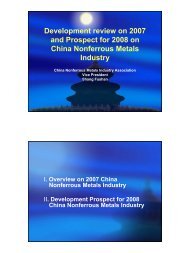Ferro-nickel / NPI Production from Laterite Nickel Ore in China
Ferro-nickel / NPI Production from Laterite Nickel Ore in China
Ferro-nickel / NPI Production from Laterite Nickel Ore in China
You also want an ePaper? Increase the reach of your titles
YUMPU automatically turns print PDFs into web optimized ePapers that Google loves.
<strong>Ferro</strong>-<strong>nickel</strong> / <strong>NPI</strong> <strong>Production</strong> <strong>from</strong> <strong>Laterite</strong><strong>Nickel</strong> <strong>Ore</strong> <strong>in</strong> Ch<strong>in</strong>aJiang X<strong>in</strong>fang– Ts<strong>in</strong>gshan Hold<strong>in</strong>g Group
1. <strong>Nickel</strong> <strong>Ore</strong> Importation <strong>in</strong> Ch<strong>in</strong>a
World Land Based <strong>Nickel</strong> ResourceSulfide28%<strong>Laterite</strong>72%World <strong>Laterite</strong> <strong>Nickel</strong> <strong>Ore</strong> ResourceResource(M Ton)Ni Content%Ni MT% of totalSulfide 10,500 0.58 62 27.8<strong>Laterite</strong> 12,600 1.28 161 72.2Total 23,100 0.97% 223 100With Vast deposit, <strong>Laterite</strong> <strong>nickel</strong> ore will be a promis<strong>in</strong>g and predom<strong>in</strong>ant resource of<strong>nickel</strong> <strong>in</strong> future;
World <strong>Nickel</strong> <strong>Laterite</strong> ResourceNew CAL24%Asia & Europe3%others2%Austrlia13%Africa8%Philip<strong>in</strong>ne16%Indonesia16%Carribean7%C&S America11%<strong>Laterite</strong> <strong>Nickel</strong> <strong>Ore</strong> Distribution<strong>Laterite</strong> <strong>nickel</strong> ore is ma<strong>in</strong>ly distributed <strong>in</strong> countries close to equator, asPhilipp<strong>in</strong>e, Indonesia, New CAL, etc. which are also close to Ch<strong>in</strong>a.
Ch<strong>in</strong>a <strong>Nickel</strong> <strong>Ore</strong> Import Quantity2500Indonesia Philipp<strong>in</strong>e New Caledonia Others LME <strong>Nickel</strong>60,000200050,000'000 T1500100050040,00030,00020,00010,0000Jan-07Feb-07Mar-07Apr-07May-07Jun-07Jul-07Aug-07Sep-07Oct-07Nov-07Dec-07Jan-08Feb-08Mar-08Apr-08May-08Jun-08Jul-080<strong>Laterite</strong> <strong>Nickel</strong> <strong>Ore</strong> Monthly Import Quantity & LME <strong>Nickel</strong><strong>Nickel</strong> ore imported <strong>in</strong> Ch<strong>in</strong>a is ma<strong>in</strong>ly <strong>from</strong> Indonesia and Philipp<strong>in</strong>e. Indonesia usually providehigher <strong>nickel</strong> grade, with <strong>nickel</strong> content over 1.6%, Philipp<strong>in</strong>e mostly supply lower grade , with <strong>nickel</strong>content less than 1.5%.<strong>Nickel</strong> ore importation is ma<strong>in</strong>ly <strong>in</strong>fluenced by LME <strong>Nickel</strong> price. Stimulated by high <strong>nickel</strong> price and<strong>NPI</strong> production boom, <strong>nickel</strong> ore import dramatically <strong>in</strong>creased <strong>in</strong> 2007 and reached historical peak <strong>in</strong>July over 2.2M ton/m, and then dropped untill end of 2007. In 2007, total annual importation around15,610,000ton;Slight recovery of <strong>nickel</strong> price <strong>in</strong> Q1 2008 created high expectation and excessive importationappeared aga<strong>in</strong> <strong>in</strong> Q2 2008; the total importation until July 2008 reached 9,150,000 ton.
<strong>Nickel</strong> ore stock'000 T10,0009,0008,0007,0006,0005,0004,0003,0002,0001,0000Sep-07 Oct-07 Nov-07 Dec-07 Jan-08 Feb-08 Mar-08 Apr-08 May-08 Jun-08 Jul-08 Aug-08J<strong>in</strong>gtangZhanjiangFangchengLanshanRizhaoTianj<strong>in</strong>Lianyungang<strong>Laterite</strong> <strong>Nickel</strong> <strong>Ore</strong> Monthly Stock <strong>in</strong> Ch<strong>in</strong>a Ma<strong>in</strong> Ports<strong>Laterite</strong> <strong>nickel</strong> ore are ma<strong>in</strong>ly unloaded <strong>in</strong> Rizhao, Lanshan, Tianj<strong>in</strong> and Lianyungang, which are closeto the <strong>NPI</strong> production prov<strong>in</strong>ce like Shandong, Henan, Hebei, and Shanxi.Stock keep <strong>in</strong>creas<strong>in</strong>g at the ma<strong>in</strong> ports <strong>from</strong> Q4 2007, <strong>in</strong>dicat<strong>in</strong>g that domestic demand cont<strong>in</strong>uouslyweaken.Congestion and demurrage dur<strong>in</strong>g unload<strong>in</strong>g cont<strong>in</strong>ued <strong>from</strong> Q2 till now <strong>in</strong> ma<strong>in</strong> ports as LianYungang, Rizhao and Lanshan.
<strong>Nickel</strong> <strong>Ore</strong> FOB Price & LMELME <strong>Nickel</strong> Cash Settlement usd/ton6000050000400003000020000100000LME Cash Settlement Ave.FOB Ni=1.6100806040200Jan-07Feb-07Mar-07Apr-07May-07Jun-07Jul-07Aug-07Sep-07Oct-07Nov-07Dec-07Jan-08Feb-08Mar-08Apr-08May-08Jun-08Jul-08Aug-08FOB price of <strong>Nickel</strong> ore: Ni = 1.6%, moisture = 30%FOB price is normally def<strong>in</strong>ed through formula based on LME <strong>nickel</strong> price, <strong>nickel</strong> content,moisture and price discount ratio;FOB price of <strong>nickel</strong> ore ( Ni = 1.6%, Fe < 15%, Moisture < 30%) reached peak at 94 usd/wt<strong>in</strong> June 2007, and drop down to around 20 usd/ton <strong>in</strong> August 2008, ma<strong>in</strong>ly due to oversupply and weak <strong>NPI</strong> production.
Sea Freight60$ USD504030223338404550423832343935423530272220100Jan-07 Jun-07 Jul-07 Aug-07 Sep-07 Oct-07 Nov -07 Dec-07 Jan-08 Feb-08 Mar-08 Apr-08 May -08 Jun-08 Jul-08 Aug-08 Sep-08Sea Freight: vessel 50,000 ton, Indonesia to Ch<strong>in</strong>a Ma<strong>in</strong> PortsBesides FOB price, sea freight was another major factor <strong>in</strong>fluenc<strong>in</strong>g <strong>nickel</strong> ore marketprice.Sea freight of vessels with capacity over 50,000 ton <strong>from</strong> Indonesia to Ch<strong>in</strong>a ma<strong>in</strong>ports reached 50 usd/ton <strong>in</strong> Oct. 2007, down to 32 usd/ton <strong>in</strong> Jan. 2008, <strong>in</strong>creasedaga<strong>in</strong> to 42 usd/ton <strong>in</strong> May 2008, and back to 22usd/ton, same as the price level <strong>in</strong>beg<strong>in</strong>n<strong>in</strong>g of 2007.
Market Prices of Different Grades150012000.9%-1.1% 1.4%-1.6% 1.8-1.9% 2.00%900RMB/T6003000Feb-08 Mar-08 Apr-08 May-08 Jun-08 Jul-08 Aug-08 Sep-08Market Price of <strong>Nickel</strong> <strong>Ore</strong> with Different Ni ContentWith <strong>in</strong>creas<strong>in</strong>g stockpile, decreas<strong>in</strong>g FOB price and sea freight and weak demand, themarket prices of various grades have been decreas<strong>in</strong>g <strong>from</strong> beg<strong>in</strong>n<strong>in</strong>g of 2008.For low grade with Ni less than 1.1%, market price dropped around 25%; while for otherhigh grades with Ni over 1.4%, market price dropped around 50%.
Importation Cost & Market Price180060016001400Import<strong>in</strong>g costSpot Market Price4001200200(RMB/t)10008006000-200Marg<strong>in</strong>400200-4000Jan-07 Mar-07 May-07 Aug-07 Oct-07 Nov-07 Jan-08 Mar-08 May-08 Aug-07-600Import Cost & Market Price of <strong>Nickel</strong> <strong>Ore</strong>: Ni = 1.6%, moisture = 30Importation cost at unload<strong>in</strong>g port = FOB + sea freight + VAT + port charges;When <strong>nickel</strong> price skyrocketed <strong>in</strong> May 2007, spot market price of <strong>nickel</strong> ore reached historically zenith andunit marg<strong>in</strong> around 500 RMB/Ton; Start<strong>in</strong>g <strong>from</strong> August until end of 2007, market price stayed lower thanimportation cost;Slightly <strong>in</strong>crease of <strong>nickel</strong> price <strong>in</strong> Q1 2008 encouraged the production of <strong>NPI</strong> and stimulated the demand of<strong>nickel</strong> ore, which warm the <strong>nickel</strong> ore market and end the loss of <strong>nickel</strong> ore trader; Follow<strong>in</strong>g <strong>nickel</strong> price drop<strong>in</strong> Q2 and Q3 bellow break-even po<strong>in</strong>t of <strong>NPI</strong>, <strong>NPI</strong> producers mostly stopped production, <strong>nickel</strong> ore demandshr<strong>in</strong>k, and market price significantly dropped to level lower than importation cost aga<strong>in</strong>.
Outlook of <strong>Nickel</strong> <strong>Ore</strong> Price <strong>in</strong> 2008Over supply of <strong>nickel</strong> ore:– <strong>Nickel</strong> m<strong>in</strong>es <strong>in</strong> medium & small scales started production <strong>in</strong> 2008;– Fierce competitions <strong>from</strong> various <strong>nickel</strong> ore m<strong>in</strong>ers queeze the m<strong>in</strong><strong>in</strong>g marg<strong>in</strong> and result <strong>in</strong>lower FOB;– Higher stock level to be ma<strong>in</strong>ta<strong>in</strong>ed <strong>in</strong> Ch<strong>in</strong>a ma<strong>in</strong> ports, over 7,000,000 ton till end of 2008;Restra<strong>in</strong>ed Demand of <strong>nickel</strong> ore:Even major local sta<strong>in</strong>less steel producers overcome technical problems of <strong>NPI</strong> application andstarted to accept <strong>NPI</strong> <strong>in</strong> 2008, but the production of <strong>NPI</strong> is limited due to– sta<strong>in</strong>less steel production cut esp. 300 series <strong>from</strong> major sta<strong>in</strong>less steel producers will cont<strong>in</strong>ue<strong>from</strong> Q2 till end of 2008;– most of blast furnaces were shut down due to high production cost and low <strong>nickel</strong> price;– electric furnaces mostly turned to the production of other <strong>Ferro</strong>-alloys esp. Fe-Cr, Fe-Mn etc.;In conclusion,<strong>nickel</strong> ore will be <strong>in</strong> oversupply <strong>in</strong> 2008, and market price will be kept <strong>in</strong> low level close to importationcost.
2. <strong>NPI</strong> <strong>Production</strong> <strong>in</strong> Ch<strong>in</strong>a
<strong>NPI</strong> Cost Structure - BFPreconditions:1) Ni % <strong>in</strong> ore = 1.6%; Ni % <strong>in</strong> <strong>NPI</strong> = 5%; Inland Transportation = 150 RMB/WT;2) January 2008: Ni ore market price = 650 RMB/WT, Coke market price = 2050 RMB/KWH4) August 2008: Ni ore market price = 400 RMB/WT, Coke market price = 2300 RMB/KWH<strong>Nickel</strong> ore cost29%5%11%3%8%44%5% 11%46%27%3%8%Inland transportationElectricityCokeCoalOthersJan. 2008 Aug. 2008Cost structure of <strong>NPI</strong> <strong>Production</strong> <strong>in</strong> Ch<strong>in</strong>a<strong>Nickel</strong> ore, coke and electricity are ma<strong>in</strong> factors <strong>in</strong>fluenc<strong>in</strong>g <strong>NPI</strong> production cost.In January, <strong>nickel</strong> ore account for 44% of total production cost of <strong>NPI</strong>, while coke for 29%;In August, with surg<strong>in</strong>g price of coke and decreas<strong>in</strong>g price of <strong>nickel</strong> ore, coke account for 46%of total cost of <strong>NPI</strong>, and ore account for 27%;In general, even <strong>nickel</strong> ore price dropped greatly, but due to coke price dramatically <strong>in</strong>crease,<strong>NPI</strong> total production cost stay <strong>in</strong> relatively same level <strong>from</strong> January to August 2008.
Market Price of CokeRMB/t350030002500200015001000Jan-07Feb-07Mar-07Apr-07May-07Jun-07Jul-07Aug-07Sep-07Oct-07Nov-07Dec-07Jan-08Feb-08Mar-08Apr-08May-08Jun-08Jul-08Aug-08Market Price of Coke <strong>in</strong> Shandong Prov<strong>in</strong>ce: Ash < 12.5%, S
<strong>NPI</strong> Cost Structure – Exist<strong>in</strong>g EFPreconditions:1) Ni % <strong>in</strong> ore = 1.8%; moisture = 30%, Ni % <strong>in</strong> <strong>NPI</strong> = 10%;2) <strong>Nickel</strong> ore price ( Ni % = 1.8%) = 550 RMB/WT; Inland transportation cost = 250 RMB/WT3) Electricity price = 0.5 RMB/KWH17%8% 1% 9% <strong>Nickel</strong> ore cost37%ElectricityInland Transportation28%CoalCalcium limeRefractory Electode, labor, tax and othersCost structure of <strong>NPI</strong> <strong>Production</strong> by electric furnace <strong>in</strong> Ch<strong>in</strong>aCompared with major electric furnaces for Fe-Ni production <strong>in</strong> the world, the exist<strong>in</strong>g electric furnaces<strong>in</strong> Ch<strong>in</strong>a are <strong>in</strong> small capacity and have• no rotary kiln - higher electricity consumption;• mostly designed for other <strong>Ferro</strong>-alloy – lower production, lower <strong>nickel</strong> recovery;•short life time of refractory l<strong>in</strong><strong>in</strong>g – higher ma<strong>in</strong>tenance cost, lower production time;Compared with blast furnace, the production cost of <strong>NPI</strong> <strong>from</strong> exist<strong>in</strong>g electric furnaces <strong>in</strong> Ch<strong>in</strong>a isslightly cheaper than blast furnace.
Cost Structure – New Project EFPreconditions:1) Ni % <strong>in</strong> ore = 1.8%; moisture = 30%, Ni % <strong>in</strong> <strong>NPI</strong> = 10%;2) <strong>Nickel</strong> ore price ( Ni % = 1.5%) = 550 RMB/WT3) Electricity price = 0.50 RMB/KWH53%<strong>Laterite</strong> <strong>Ore</strong>ElectricityFuel coalReductant coal19%Refractory14%2%6%6%Labor, tax and othersCost structure of <strong>NPI</strong> New Projects <strong>in</strong> Ch<strong>in</strong>aCompared to blast furnaces and exist<strong>in</strong>g electric furnaces, electric furnaces of newly establishedprojects are cost sav<strong>in</strong>g and environmental-friendly, with• rotary kiln – lower electricity consumption;•dedicatedly designed and big capacity - higher production & <strong>nickel</strong> recovery, lowerma<strong>in</strong>tenance;•close to sea ports – no <strong>in</strong>land transportation cost;Except sea freight as additional cost, newly built electric furnaces <strong>in</strong> Ch<strong>in</strong>a have no disadvantagescompar<strong>in</strong>g with other Fe-Ni production furnaces <strong>in</strong> other countries.
Major <strong>NPI</strong> Projects <strong>in</strong> Ch<strong>in</strong>aInvestorLocation<strong>Nickel</strong> Capacity(tpa)Process<strong>Production</strong>TimeS<strong>in</strong>osteel & Baosteel Hebei 16,000 2*33000 kva 2009 Q2Fujian Desheng <strong>Nickel</strong>Products Co. LtdFu Jian 50,0002*450 M 34*25000 kva2009 Q3Q<strong>in</strong>zhou Heng X<strong>in</strong><strong>Nickel</strong> Products Co. LtdGuangxi 10,000 4*12500kva 2009 Q1Ts<strong>in</strong>gshan Hold<strong>in</strong>g Group Fu Jian 20,000 2*33000 kva 2009 Q2Q<strong>in</strong> Hai Aokai CoalDevelopment Group Co.ltdQ<strong>in</strong>g Hai 20,0004*125000 kva6*25000 kva2009 Q2
3. <strong>NPI</strong> Demand Analysis
Sta<strong>in</strong>less Steel <strong>Production</strong> In Ch<strong>in</strong>akt1000090008000700060005000400030002000100008683755052923290180020841050500 6002000 2001 2002 2003 2004 2005 2006 2007 2008Sta<strong>in</strong>less Steel <strong>Production</strong> <strong>in</strong> Ch<strong>in</strong>aIn 2007, the total sta<strong>in</strong>less steel production reached over 7,550,000 ton, which was 15 timesthe production of 2000.In 2008, even sta<strong>in</strong>less steel market stays weak, but the production will cont<strong>in</strong>ue the growthrate as 1.5 x GDP as around 15% to reach 8,600,000 ton;Cont<strong>in</strong>uous growth of sta<strong>in</strong>less steel production <strong>in</strong> Ch<strong>in</strong>a will create last<strong>in</strong>g growth of Niconsumption.
Sta<strong>in</strong>less Steel Product structure120%100%5% 5.0% 6.0% 7.0% 9.0% 11.0% 13.0% 17.0% 17.0% 16.0% 17.00%80%23% 22.0% 21.0% 21.0%23.0%25.0% 23.0%27.0% 25.0% 26.0% 27.00%20060%40030040%20%72% 73.0% 73.0% 72.0% 68.0% 64.0% 64.0%56.0% 58.0% 58.0% 56.00%0%2000 2001 2002 2003 2004 2005 2006 2007 2008 2009 2010Percentage of 300 and 200 & 400 series sta<strong>in</strong>less steel production <strong>in</strong> Ch<strong>in</strong>aFrom 2000 to 2006, 200 and 400 series percentage <strong>in</strong>creased due to high growthrate and substitution of 200 & 400 <strong>in</strong> applications as automobile, householdappliance, and architectures, etc.In 2007, due to high and unstable <strong>nickel</strong> price, 300 series dramatically decreasedby 8%; <strong>in</strong> the com<strong>in</strong>g years, due to technical reasons, the percentage of 300 willma<strong>in</strong>ta<strong>in</strong> over 55%;
<strong>Nickel</strong> Demand of Sta<strong>in</strong>less Steel <strong>Production</strong>kt300200151247317kt70.0%50.0%61.1%62.6%60.3%Primary Ni67.2%100103Secondary Ni38.9% 39.7%37.4%02004 2005 2006 200730.0%32.8%2004 2005 2006 2007<strong>Nickel</strong> consumption of Sta<strong>in</strong>less Steel <strong>in</strong> Ch<strong>in</strong>aPercentage between primary and secondaryNi for sta<strong>in</strong>less steel production <strong>in</strong> Ch<strong>in</strong>aFigures proved the cont<strong>in</strong>uously <strong>in</strong>crease of <strong>Nickel</strong> consumption <strong>from</strong> sta<strong>in</strong>less steelproduction; but the <strong>in</strong>crease rate is mild <strong>in</strong> 2007, due to sta<strong>in</strong>less steel production cut and 400& 200 percentage <strong>in</strong>crease;Percentage between primary and secondary <strong>nickel</strong> shown that primary <strong>nickel</strong> was more andmore preferable to sta<strong>in</strong>less steel producers;In 2007, <strong>NPI</strong> contribute around 90,000 <strong>nickel</strong> for sta<strong>in</strong>less steel production <strong>in</strong> Ch<strong>in</strong>a, as majordriver of primary <strong>nickel</strong> percentage <strong>in</strong>crease.
Market Prices of <strong>NPI</strong>Yuan/1%Ni31002900Ni:1.6%-1.7% Ni:4%-6% Ni:10%-15%2700250023002100190017001500Feb-08 Mar-08 Apr-08 May-08 Jun-08 Jul-08 Aug-08 Sep-08<strong>NPI</strong> Market Price <strong>in</strong> Ch<strong>in</strong>a<strong>NPI</strong> with Ni content 10% was slightly <strong>in</strong>creased by 9% <strong>in</strong> March 2008, then dramatically dropped by40% and close to production cost <strong>from</strong> March to Sept. 2008.<strong>NPI</strong> with Ni content 5% was also <strong>in</strong>creased by 14% <strong>in</strong> March, then dropped by 20% till Sept. 2008with no marg<strong>in</strong> for producers.For <strong>NPI</strong> with Ni content less than 2%, it was ma<strong>in</strong>ly used as major resource of Iron for sta<strong>in</strong>lesssteel, esp. 200 series. Due to <strong>in</strong>creas<strong>in</strong>g iron price, <strong>NPI</strong> with <strong>nickel</strong> less than 2% <strong>in</strong>creased greatly<strong>in</strong> August, and some blast furnace turned to produce low grade <strong>NPI</strong> for better marg<strong>in</strong>. But <strong>in</strong> Sept.when iron price start to drop, low grade <strong>NPI</strong> price also started to drop.
Comparison ofPrimary and Secondary <strong>Nickel</strong> Price280,000250,000220,000(RMB/MT)190,000160,000130,000100,000Jan Feb Mar Apr May Jun Jul Aug Sep<strong>Nickel</strong> Imported FeNi <strong>Nickel</strong> pig iron Domestic scrap<strong>Nickel</strong> cost comparisonThe curves expla<strong>in</strong>ed <strong>nickel</strong> cost difference <strong>from</strong> various resources as <strong>nickel</strong>, imported Fe-Ni, local <strong>NPI</strong>,and SS scrap;Deduct the cost of iron and chrome <strong>from</strong> Fe-Ni, <strong>NPI</strong> and SS scrap, <strong>NPI</strong> was shown a big cost advantagecompar<strong>in</strong>g with other <strong>nickel</strong> resources <strong>in</strong> 2007 and first half of 2008;With <strong>nickel</strong> price further down <strong>in</strong> Q3 and <strong>in</strong>creas<strong>in</strong>g production cost of <strong>NPI</strong>, market price of <strong>NPI</strong> has noroom to decrease further, and gradually lost cost advantages compar<strong>in</strong>g with Fe-Ni import and <strong>Nickel</strong>.
Comparison ofPrimary and Secondary <strong>Nickel</strong> PriceRMB/Ton160000155000150000145000140000135000<strong>Nickel</strong> Import Domestic <strong>Nickel</strong> Imported FeNi <strong>Nickel</strong> Pig iron Domestic 304 scrap153,500151,249145,630142,135132,2451300001250001200002008/9/15<strong>Nickel</strong> cost comparison on Sept. 15, 2008The curves expla<strong>in</strong>ed <strong>nickel</strong> cost difference <strong>from</strong> various resources as imported <strong>nickel</strong>, local <strong>nickel</strong>,imported Fe-Ni, local <strong>NPI</strong>, and local SS scrap based on data on Sept. 15, 2008.As a resource of <strong>nickel</strong>, <strong>NPI</strong> has lost cost advantage compar<strong>in</strong>g with Fe-Ni imported, and slightlycheaper than <strong>nickel</strong>.
<strong>NPI</strong> Consumption <strong>NPI</strong> application will be temporarily threatened by low LME <strong>nickel</strong> price below 18,000.Dim<strong>in</strong>ish<strong>in</strong>g cost advantage will limit the consumption to certa<strong>in</strong> degree, but <strong>NPI</strong> will notdisappear. <strong>Production</strong> cost cut <strong>from</strong> ore, coke, sea freight and technical improvement to reduceconsumption have supported producers left <strong>in</strong> the market; <strong>NPI</strong> Consumption Estimated <strong>in</strong> 2008:• 180,000 – 250,000 ton/m• Mostly with <strong>nickel</strong> content 5 – 8%, 1-2% ma<strong>in</strong>ly for 200 series• 120,000 – 150,000 ton
Challenges and Opportunities Challenges– <strong>Nickel</strong> price below break even po<strong>in</strong>t;– <strong>Production</strong> facilities and process to be upgraded;– Sea freight <strong>in</strong>crease and <strong>in</strong>stability;– Export policy changes of <strong>nickel</strong> ore;– More and more strict requirements of environmental protection and energysav<strong>in</strong>g; Opportunities– Consistent growth of Ch<strong>in</strong>ese sta<strong>in</strong>less steel <strong>in</strong>dustry create promis<strong>in</strong>g demandof <strong>NPI</strong>;– New projects with advanced equipment and process will <strong>in</strong>sure thecompetitiveness of production cost, product quality, and environmental protection<strong>in</strong> the long run;– Sufficient <strong>nickel</strong> ore supply secured through active oversea <strong>in</strong>vestment;
Thanks for your attention!


